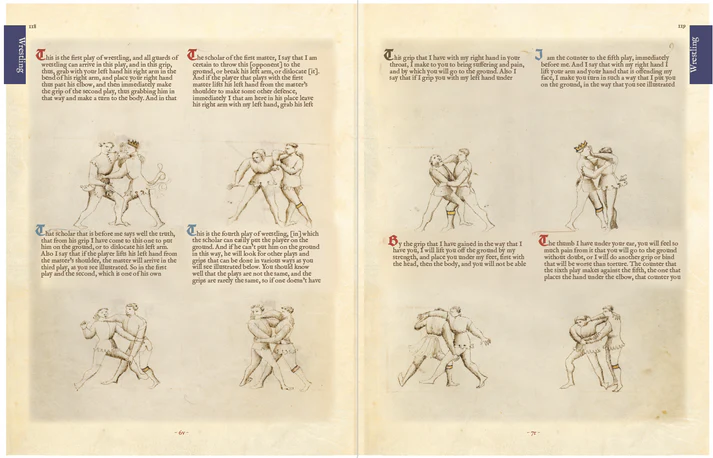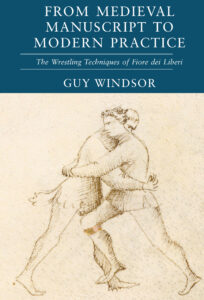
One of the most stylish techniques in the system is the punta falsa, literally “false thrust”. Fiore’s instructions are very detailed:
Questo zogo si chiama punta falsa o punta curta, e si diro come la fazzo. Io mostro d’venire cum granda forza per ferir lo zugadore cum colpo mezano in la testa. E subito ch’ello fa la coverta, io fiero la sua spada lizeramente. E subito volto la spada mia de l’altra parte piglando la mia spada cum la mane mia mancha quasi al mezo. E la punta gli metto subita in la gola o in lo petto. E de miglore questo zogo in arme che senza.
This play is called the false thrust or the short thrust, and I’ll tell you how I do it. I show that I am coming with great force to strike the player with a middle blow in the head. And immediately that he makes the cover I strike his sword lightly. And immediately turn my sword to the other side, grabbing my sword with my left hand about at the middle. And I place the thrust immediately in the throat or in the chest. And this play is better in armour than without.
This is the 17th play of the second master of the zogho largo, and so in its basic form is done as a riposte after a successful parry of the first attack (as shown by said master). It can of course be done any time there is an opening to throw the mezano feint, but let’s start out being strictly canonical. We bring this to life like so:
https://youtu.be/BkhdctzyE2g
When practising the punta falsa, there are some things to bear in mind.
- Make sure you leave enough space to turn your sword when feinting. A small step offline with the back foot can help, when making the feint.
- Keep the turn of the sword tight, by rotating it around the midpoint of the blade, then let the point lead you in.
- Cross-handed pairs will find that the punta falsa only works when there is a forehand (mandritto) mezano being met by a parry on the inside of the attack. This allows the turn to half-sword, which is only mechanically possible from this situation. A left-hander will therefore need to strike the mezano to generate a parry from their opponent’s left side; right-handers need to draw a parry from the opponent’s right side.
Incidentally, in Italian, punta can mean ‘point’ (as in the point of the sword), or ‘thrust’, depending on context. So you may find the term punta falsa translated as ‘false point’, and punta curta as ‘short point’. (or indeed, references to ‘exchanging the point’ or ‘breaking the point’). It doesn’t actually matter from an interpretation standpoint, but as a fencer, I would be more inclined to think about actions rather than parts of the sword. Where it matters are when Fiore is telling us which bit of the swords are crossed (such as in the first master of the zogho largo, crossed at the points of the swords), or where to grab the blade (see for instance the 14th play, where we should grab it ‘near the point’). This has changed over time: in modern Italian ‘a thrust’ is ‘una spinta’, while ‘point of the sword’ remains ‘la punta della spada’.
We should also think a moment about the ‘better in armour’ injunction. Why would Fiore put a play here that apparently belongs in the armoured section? As I see it, it is because firstly it can be done out of armour – it’s quite safe to do if you get it right. And secondly, this play is something that a person wearing armour when you are not might do, and as we shall shortly see, the counter works just fine out of armour.
The next play is the last play of the zogho largo; the instruction is simplicity itself, but the action is very counterintuitive for most people.
Questo sie lo contrario del zogho ch’e me denanzi, zoe de punta falsa overo di punta curta. E questo contrario si fa per tal modo. Quando lo scolaro fieri in la mia spada, in la volta ch’ello da a la sua spada, subito io do volta a la mia per quello modo che lui da volta a la sua. Salvo che io passo ala traversa per trovar lo compagno pui discoverto. E si gli metto la punta in lo volto. E questo contrario e bono in arme e senza.
This is the counter to the play that is before me, so, the false thrust or short thrust. And this counter is done in this way. When the scholar strikes on my sword, in the turn that he makes with his sword, I immediately make a turn to mine, in the same way that he makes a turn to his. Only I also pass across to find the companion more uncovered. And I place the thrust in his face. And this counter is good in armour and without.
The exact nature of the blade action and the relationship between the weapons was first figured out, as far as I know, by Sean Hayes at WMAW 2006. We had just attended a lecture on the manuscript given by Brian Stokes, and seen really high resolution scans for the first time- so clear that places where the manuscript had been corrected (by scraping off the original ink and redrawing a line) could be seen. The counter-remedy master’s sword was suddenly, clearly, on the inside of the player’s (the one trying to do the punta falsa). I will never forget the time about half an hour later when Sean tried out this interpretation on me, and sold it in one go as my attack collapsed as his point magically appeared in my mask.
Here’s how it looks in practice:
https://youtu.be/E4Y0AAZ9Z_0
Perhaps the most common problem when attempting this counter is ending up outside your opponent’s sword. Don’t worry, that’s how everybody did this play for years. It works, it just takes longer. It can also be documented in other sources, so it’s even historically accurate. But if your partner does it, yield immediately to pommel strike on the other side.
The text continues on this page with two paragraphs side by side, with no illustrations:
Qui finisse zogho largo dela spada a doy mani, che sono zoghi uniti gli quali ano zoghi, zoe rimedii e contrarie da parte dritta e de parte riversa. E contrapunte e contratagli de zaschuna rasone cum roture coverte ferire e ligadure, che tutte queste chose lizerissimamente se porio intendere.
Here ends the wide play of the sword in two hands, that are joined together plays, which plays are: remedies, and counters from the forehand and the backhand side, and counterthrusts and countercuts of ever type, with breaks, covers, strikes and binds, that all these things can be very easily understood.
This passage is actually quite tricky to translate, as the second line is unclear: ‘che sono zoghi uniti gli quali ano zoghi, zoe…’
I am translating ‘zoghi uniti’ as ‘joined together plays’, in the sense of they are joined (united) in some way. It’s a clunky sentence, I think. Though the meaning of it is reasonably straightforward to tease out, the exact grammar makes no sense to me. Then Fiore continues with what appears to be a bare-faced lie: these ‘joined together plays’ are apparently “remedies, and counters from the forehand and the backhand side, and counterthrusts and countercuts of ever type, with breaks, covers, strikes and binds.” We have seen nothing, zip, nada, from the backhand side, and while we have arguably seen a counterthrust, countercuts have there been none. Plus, there has been exactly one counter-remedy (the last play of the section), so not ‘contrarie’, counters plural. Unless we count the 14th play, which kind of counters the break and is then countered.
So what do we do with this statement?
I think we go back and play. And sure enough if we take this material and play with it, pretty soon we do end up doing all these different things. Applying the exchange of thrusts idea to cuts gives us something astonishingly like a zornhau ort, for instance.
What’s a zornhau ort? Don’t you read the German stuff too? It’s really interesting… basically, it’s when a mandritto fendente (sorry, forehand oberhau) is met with the same blow, leaving the defender’s point in the attacker’s face. We’ll need something like that for the next section, so I’ll go into it then.
The plays of the zogho stretto are coming up. Take a look at this two-page spread:

The master of the zogho stretto is the first play on the recto page. The text introducing the stretto plays is at the bottom of the verso page. This makes perfect sense when you see the pages as they are bound in the manuscript, but the sense is lost when you look at individual pages. Or worse, when the pages are bound such that the verso pages are printed on the recto side, and vice versa.
The text reads:
Qui cominza zogho de spada a doy man zogo stretto, in lo quale sara d’ogni rasone coverte, e feride e ligadure e dislogadure e prese e tore de spade, e sbatter in terra per diversi modi. E sarano gli remedij e gli contrarij de zaschuna rasone ch’e bisogna a offender e a defender.
Here begins the play of the sword in two hands zogo stretto, in which will be, of every type, covers, and strikes, and locks, and dislocations, and grips, and disarms, and throwings to the ground in various ways. And there will be remedies and counters of every type necessary to offend and defend.
Well, that sorts us out then. It reads like a trailer for a movie: there’ll be drama! And excitement! And explosions! And sticky situations over a pound note! Don’t miss it!
(Full marks if you spotted the Blackadder reference. If you don’t know what Blackadder is, start here. The reference is from Season Three episode Ink and Incapability).
I am now working on the next section, the stretto plays. I’ve been thinking though of not publishing them here, just making them available as part of the book I’m compiling from this series (provisionally titled “Fiore dei Liberi’s Longsword Plays on Foot Out of Armour”). What do you think?
And in the meantime, you can get parts one to three as snazzy ebooks here for reading on your phone, kindle, kobo, or other device.
You can get part one, The Sword in One Hand, as a free PDF by subscribing to my mailing list below, or buy it in ebook format from Amazon or Gumroad.
You can get Part two, Longsword Mechanics, from Amazon or Gumroad
And you can get Part three, the Plays of the Zogho Largo, from Amazon or Gumroad.


















